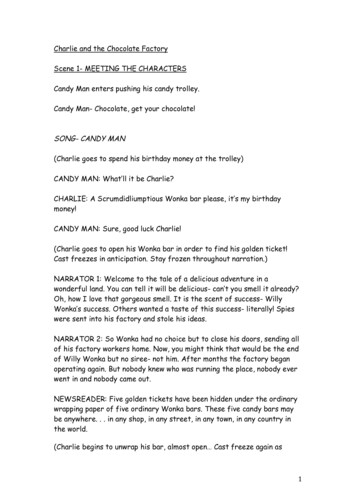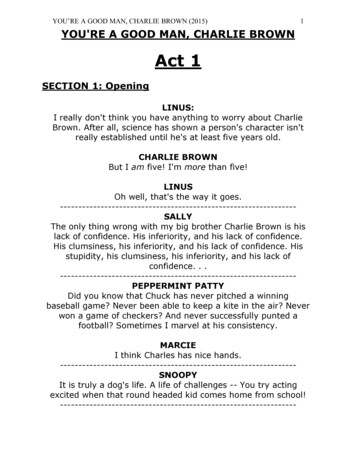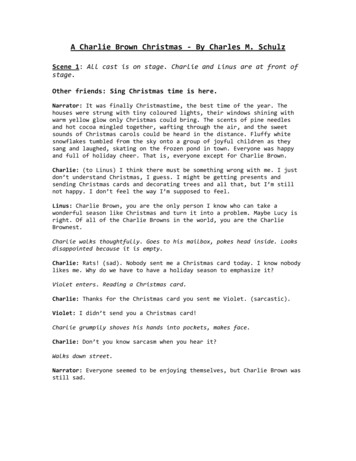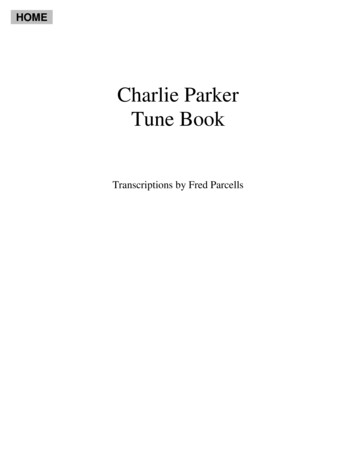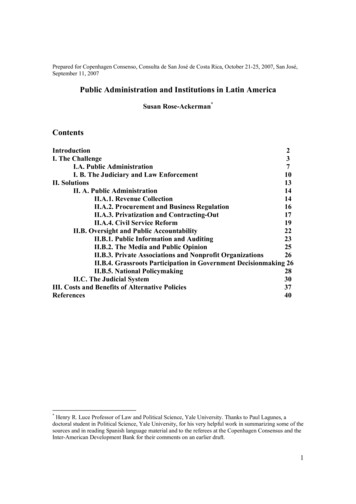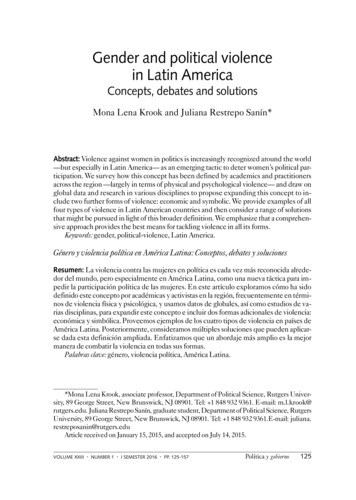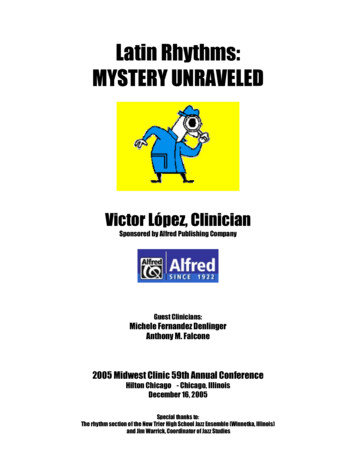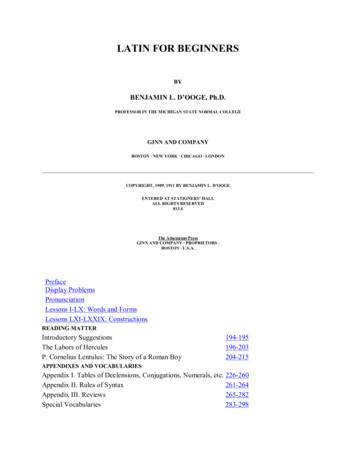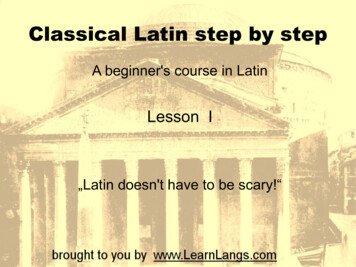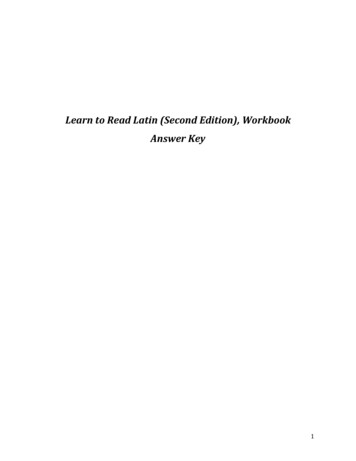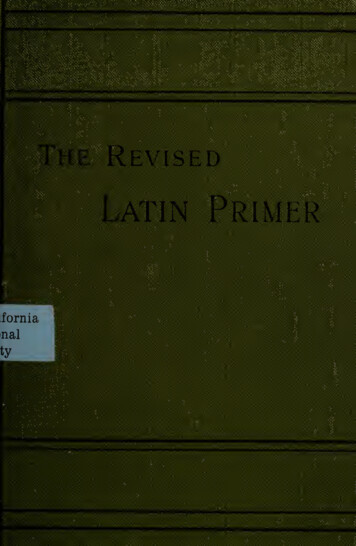
Transcription
REVISED[ATTMJUAIUNO T RIMcKT \ T?"Dfi
UCSB LIBRARY
74.
THEREVISEDLATIN PRIMERBTBENJAMIN HALL KENNEDY,D.D.FORMERLY FKLLOW OSST. JOHN'S COLLEGE, CAMBRIDGEREGIUS PROFESSOR OF GREEKA.NDCANON Or ELYTWELFTH IMPRESSIONLONGMANS, GKEEN, AND39PATERNOSTEK ROW, LONDONNEW YORK AND BOMBAY1906All rights reservedCO.
Bythe same Author.THE SHORTER LATIN PRIMER.Fcp. 8vo. priceONE SHILLING.AUTHOR'S PREFACE.published in compliance with a wish expressed to me bya large number of Masters, including many teachers in Preparatory Schools,and in the lower forms of Public Schools.Tnislittle boofc isIt is intended to be a simple manual for beginners in Latin, preparatoryto the use of the Revised Latin Primer.In order to facilitate the passage of the learner from one book to theother, and also to make it possible for them to be used side by side ifnecessary, this Shorter Primer has been made, as far as it goes, in the mainidentical with the Revised Primer, and arranged on the same plan.It contains the memorial portion of the Accidence, with a few of themost important notes and explanations, and the more elementary parts ofthe Syntax of the Simple Sentence.A short outline of the Compound Sentence, which did not form part ofmy original plan, has been added in accordance with the desire of severalexperienced teachers, In this part it has been necessary, for the sake ofbrevity, to make the arrangement and wording somewhat different fromthat of the Revised Primer,In this book, as in the Revised Primer, I have endeavoured to simplifythe marking of quantity by placing the mark of quantity, as a rule, only onthe long vowels. It must therefore be noted that vowels not marked aregenerally to be taken as short, short quantity being only marked wnere ithas seemed necessary to guard against mistake.EXERCISES ON THE SHORTER LATIN PRIMER.By M.andG.J. E.KENNEDY, andCrown8vo.1*.H.WILKINSON,6d.LONGMANS, GREEN, &39 PaternosterCO.Row, London, New York, and Bombay.M.A.
PEEFACETHISBOOKisa complete revision of the Public SchoolLatin Primer.The report of the Public School Commission of 1862having recommended the use of a common Latin Grammarin Public Schools, theinthatHead Masters ofCommission resolvedLatin Grammar, which hadused, as the basis of such athe Schools includedadopt my Elementarysome years been widelycommon Grammar, and thetoforPublic School Latin Primer, prepared in accordance withthat resolution, was published with their sanction in theyear 1866.During the period which has since elapsed, variousimprovements have from time to time occurred to me orbeen suggested by others.But, looking at the jointauthority under which the Primer was issued, I did notmyself free to introduce into it the alterations whichunder other circumstances I should have made. When,,however, I found that a revision of the Primer was generallyfeeldesired,and when,aftercommunication with the ConferenceHead Masters, I found myself in a position to act inthe matter of revision upon my own responsibility, I gladlyentered upon the work of which the present Ee vised Primerofisthe result.Myfirststepwasto collect as widely as
PREFACEfvpossiblefromMastersPublic and PrivateofSchoolsopinions with regard to the objections to the Primer as itstood, and the nature and extent of the changes whichdeemedWith thekind and generous aid of my old pupils and friendsMr. Hallam, of Harrow, and Mr. Page, of Charterhouse, andby the courtesy of many teachers who have communicatedteachers of experiencewithto be desirable.me either directly or through them,Ihave been enablednumber of valuable suggestions on theseThe aim which I have kept steadily in viewto obtain arevision of thein thisPrimer has been that the book should besuitable both for beginnersFormpoints.andfor allboys up to fhe Fifthin Public Schools.The greatest care has been taken to make the arrangement in respect of form as clear and plain as possible. Forthispurpose I have(1)brought into the text under theappropriate headings the matter which in the originalPrimer is contained in Appendix I. (2) omitted such tech;seemed to be reasonably open to objection.The Declension of Substantives and Adjectives has beennical terms asarranged upon theclassed as far as'Stem'principle,and the words arepossible in accordance withresults of the comparative study of Latinthe latestand the relatedThe oldlanguages, especially the ancient Italian dialects.order of the Declensions has, after careful consideration,been retained.In a text-book of this kind thereisanobvious advantage in keeping, wherever it is possible, apopular and well-understood system, and I believe that theold order of Declensionis,from a purely philological pointof view, wholly unobjectionable.With regardto Verbs, I
PREFACEvhave adhered in the Paradigms to the arrangement of thefour Conjugations, as I am satisfied that an alterationwould involve such inconvenience to teacher and learner aswouldoutweigh any possible gain in scientific accuracy.To meet a general wish, I have prefixed to the Accidencefara chapter on Letters and Laws of Sound. I desire it to beunderstood that this chapter is placed at the beginning ofthe book because that seemed to me to be the most naturaland, for purposes of reference, the most convenient positionfor itand not from any intention that it should necessarilybe learnt as a whole at the outset.Ihave purposely refrained from any attempt to givefixed rules for the pronunciation of Latin, because in thapresent stage of the investigation of that subject, such rulescould be only of a provisional kind.have so far been reachedIFor theresultswhichwould refer to the small pam-phlet lately issued by the Cambridge Philological Society.In order to simplify as far as possible the marking ofquantity, I have marked the quantity as a rule only on thelong vowels. In this book vowels which have no mark ofquantity are generally to be taken as short, and the shortquantityismarked only whereitseems especially necessaryto guard against mistake.The memorial lines on Gender are placed in an appendixinstead of being, as in the original Primer, included in thetext.Throughout the book except in a few cases in the chapon Letters and Laws of Sound, where Word-formation,not Grammar or meaning, is being dealt with Latin wordsterare immediately followed by their translation in English.
PREFACEviSomeof theseimprovements of course involve additionalprinted matter, but the addition is rather in the apparentsize of the book than in the actual matter to be learnt.In conclusion I offerHead Masters andmy cordial thanks to many teachers,.Assistant Masters in Public Schools, andPrivate Schools (among whom I mustmention especially the Eev. E. D. Stone and Mr. C. S. Jerrarn)also Masters ofwhich they have directly and indirectlyby communication and correspondence.for the assistancerendered tomeOf the special co-operation which has been given throughout by Mr. Page and Mr. Hallam I have already spoken.For many reasonstheir constant help has been tomeinvaluable.During the progress of the work I have received criticismson many points of philology and grammar from my friendsDr. Peile, Master of Christ's College, and Professor J. E. B.Mayor, which, last, but not least, I desire gratefully toacknowledge.B. ILTHE ELMS, CAMBRIDGEMayKENNEDY.:1888.PREFACE TO THE SEVENTH EDITION.IN bringing out the present edition the Editors have takenmake some improvements in points ofwhich have been suggested to them by variousTeachers.They desire in particular to thank Mr. FrankKitchie for several criticisms and suggestions.the opportunity todetail
CONTENTSPAQ31ECTIOS1.THE LATIN LANGUAGE2.LETTERS AND LAWS OF SOUND.1.224.FLEXION25.PABTS OF SPEECH1226.DECLENSION AND GENDER131132.DECLENSION OF SUBSTANTIVES67.DECLENSION OF GREEK NOUNS70.DECLENSION OF 437414548102.TABLE OF CORRELATIVES103.VERBS56115.62134.VERB PARADIGMSIRREGULAR VERBS142.DEFECTIVE VERBS. 548590143.IMPERSONAL VERBS92147.FORMATION OF VERB STEMS93152.TABLE OF VERB PERFECTS AND CTIONS110180.INTERJECTIONSIll181.INTRODUCTION TO THE SIMPLE -THETHETHETHETHE98SYNTAX.NOMINATIVE AND VOCATIVE CASES.113116.119ACCUSATIVE CASE119DATIVE CASE123ABLATIVE CASE127GENITIVE CASE.133
CONTENTSviiiSECTIONPAGB268.PLACE, TIME, AND SPACE284.PREPOSITIONS143288.146296.IMPERSONAL VERBS (CASE CONSTRUCTION)PASSIVE NSES157344.MOODSTHE VERB INFINITE159364.140374.THE INFINITIVEGERUND AND NS171405.QUESTION AND ANSWEBTHE COMPOUND SENTENCE172168410.INTRODUCTION411.SEQUENCE OF TENSES174 175413.SUBSTANTIVAL CLAUSES176421.ADVERBIAL CLAUSES180450.ADJECTIVAL CLAUSES192458.OBATIO OBLIQUA470.471.NARRATIVE IN ORATIO EXI.INDEXII.:.ROMAN MONEY, WEIGHTS, MEASURES, AND TIME.209.214FIGURES OF SPEECHSUBJECTS:201DERIVED AND COMPOUNDED WORDSAPPENDIX IV. -MEMORIAL LINES ON GENDERLATIN WORDS194198218.221227.233
LATIN PEIMEE.THE LATIN LANGUAGE.LATIN was the dialect of the Latini, or people of Latium in Italy.It was spoken by the ancient Eomans, and, as their poets andprose-writers all used this dialect, the language was called Latin,not Koman.Latin belongs to the family of languages known as IndoEuropean, or Aryan the other languages of this family are, inAsia, the Indian, which includes Sanskrit, and the Iranian inEurope, the Keltic, the Teutonic, the Greek, the Slavonic, andthe Lettic. The imperial power of Kome made Latin the generalspeech of Western Europe, and from it are derived the modernItalian, French, Spanish, Portuguese, and Wallachian, hence;;Komance languages.calledIn England, after its conquest by the Angles and Saxons,of the Teutonic language, called Anglo-Saxon, or oldEnglish, was spoken. From about the tenth century, and especiallyafter the Norman Conquest (1066 A.D.), this became mixed withNorman French, a Bomance dialect, an offshoot of Latin. Aiter therevival of learning in the sixteenth century, a large number of wordswere brought into English direct from Latin, and more have beenadded since, so that to understand the English language thoroughlyit is necessary to have a knowledge of Latin.Note.a branchTheitwasinfluence of Greek civilisation on Latinbegan about 550 B.C.,with the Greek colonieswas very great;The first of thesethrough the commerce of the RomansThe second may bein Southern Italy.chiefly exerted attwodistinct eras.
THE LATIN LANGUAGEdated from the third century B.C., when literary activity began atRome. This influence was further developed through the conquest of Greece byEome,whicfiwas completed 146B.C.All Latin literature, except the satiric writings of Horace,and Juvenal,Persius,isformed on Greek models.Theearliestspecimens of Latin we possess are inscriptions, laws, annals,fragments of songs.Theandcredit of authorship is first ascribed to Livius Androsaid to have exhibited plays at Rome 240 B.C. Thenicus, who isworks of the poets who followed soon after this date have mostlyperished, except the comedies of Plautus and Terence, about200 to 140 B.C., and a prose fragment of the elder Cato.The ages regarded80B.C., lastingas classicalmaybe said to begin aboutabout 200 years.Golden Age ended with the death of Augustus,the Silver Age began, ending about 120 A.D.The authors most studied are in prose, Cicero, Caesar, Livy,Tacitus in poetry, Lucretius, Vergil, Horace, Ovid, and Juvenal.TheA.D.so-calledwhen14,;LETTERS AND LAWS OF SOUND.2The Latin Alphabet.The Latin Alphabetthree letters, with the following signscontains twenty-:ABCDEFGHI(J)KLMNOPQRSTU(V)XYZabode fghi(j)klmnopqr stu(v)xyzIn early times C was written to represent the sounds of bothG, which were probably not clearly distinguished in speaking.Afterwards G was made out of C, and K becoming superfluous wentNote.C andY and Z were added in Cicero's time, being borrowedfrom the Greek alphabet, but they are only found in wordstaken from the Greek.out of use.directTheletters are divided into:1.Vowels or Sonants (sounding by themselves)2.Consonants (sounding with a vowel).;
LAWS OF SOUNDVOWELS.The pure vowels3andare a,oe,;iand u are classed as vowelsandalso as semi-consonants, because they have both vowelconsonant sound.The most open soundthe closest flat soundand oisisaisu;e;the closest sharp sound is i andintermediate between a and i,;isintermediate between a and u.aoeuiy4always a vowel, as in lyra, and was sounded as Frenchis?AEach of the five vowels can be eitherwhen pronounced quickly, like English aQuantity of Vowels.short or longin man', longAshort:whenthe voice dwells on the sound, as in far.distinguished by the sign , a long one byamo. Thus the five vowels stand for ten differentshort vowelthe sign -sounds:is:a,a,e,e,i,I,o,o,u,u.There were no doubt many finer shades of sound for eachvowel, which cannot be exactly ascertained, but the followingfive words may give an approximate idea of their pronunciation.quinine, demesne, papa, prSpose, Zulu.Note.A.Aposition.'vowel,5isvowel before two consonants is said to be long byvowel before another vowel, or before h followed by a'nearly always short.Diphthongs. A Diphthong (double sound) is formed by twovowels meeting in one syllable. The diphthongs commonlyfound in Latin are ae, oe, au more rarely eu Caesar, moenia,;:laus, heu.In the oldest Latin there were six diphthongs ai, au, ei,Of these, ai passes in classical Latin into ae,:eu, oi, ou.v 2
LAWS OF SOUNDmensaeformensai;au remains unchanged;ei isfound inold inscriptions, but in the literary language its place is takenby e or by I, as in dico, except in the exclamation ei ; eu isfound in ceu, heu, neu, seu, and in many words of Greekoi passes into oe, and sometimes into later u;poena,punio; o
erthe revival of learning in thesixteenthcentury,alarge number of words werebroughtintoEnglish direct from Latin

